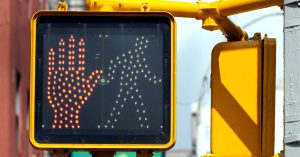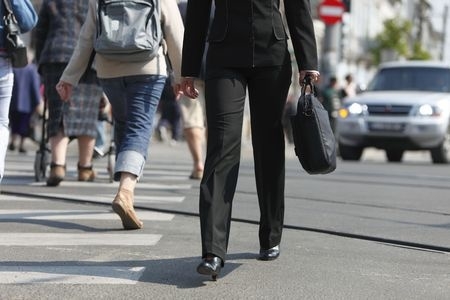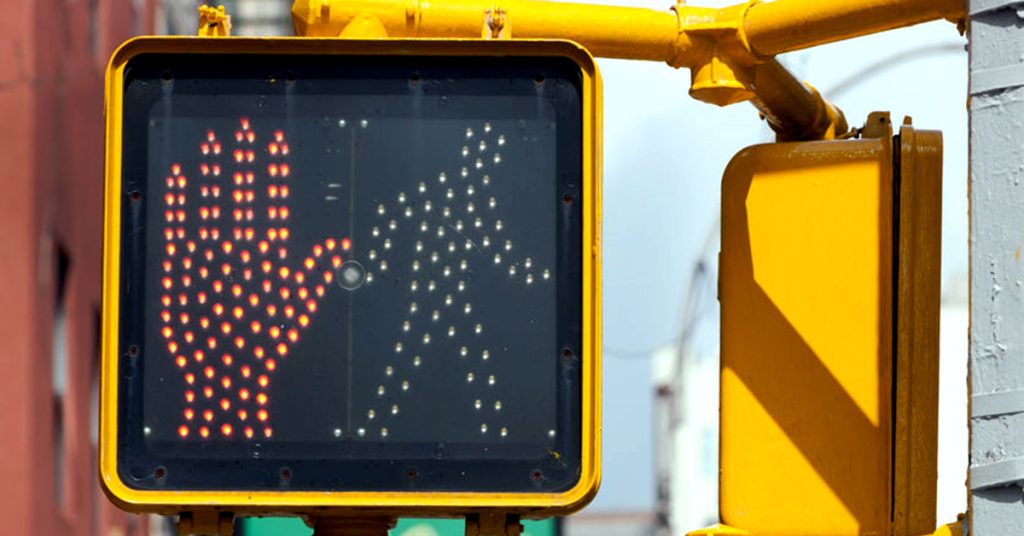Posts Tagged ‘“pedestrian fatalities”’
More Pedestrian Accidents Were Fatal in Massachusetts Last Year

Dangerous roads: There were more pedestrians killed in traffic accidents in Massachusetts during 2021.
As the New Year begins, Massachusetts closes the door on a very dangerous year for pedestrians.
There was disappointing news on the state’s roads, as traffic fatalities rose 19 percent over 2020, according to MassDOT preliminary data (January 4, 2022). But those who walked faced the most risks. Pedestrian fatalities increased a stunning 38 percent, coming in near pre-pandemic levels.
Statewide, 76 pedestrians were killed in motor vehicle accidents last year, compared to 2019, when there were 78 deaths. The state recorded 55 pedestrian deaths in 2020, when traffic volumes fell early on during the Massachusetts “stay-at-home” and essential worker orders.
Most concerning is when a driver injured a pedestrian last year, the encounter was more often fatal. According to the January 4th data, in Massachusetts, you had a greater chance of surviving a pedestrian accident in 2019 than you did last year.
The state recorded about 2,197 pedestrian accidents in 2019. About 3.5 percent of these resulted in fatal injuries. Meanwhile, in 2021, there were 1,520 reports of motor vehicle accidents involving pedestrians. Five percent of these crashes claimed a pedestrian’s life.
These are preliminary numbers from the MassDOT. It is important to remember these could rise in future days and weeks.
Drivers Have a Duty to Decrease Speed At Times for Safety
Drivers may operate recklessly or make unsafe choices, such as speeding or running a red light, during any season. Come winter, when the snow and ice arrive, these decisions can be deadly for pedestrians. Drivers may have less time to make corrections.
In Massachusetts, drivers have a duty to use reasonable care and this includes traveling at a safe speed.
Drivers have a duty to observe the posted speed limit as the maximum that is “reasonable and proper.” But they must use good judgment and lower their speed for safety, “when a special hazard exists with respect to pedestrians or other traffic, or by reason of weather or highway conditions.” M.G.L. c. 90, § 17.
This describes many winter driving situations.
Still, as a pedestrian, you should expect drivers may speed and approach you too closely in the winter. While you cannot control this, you can try to stay visible. When drivers see you, they may recognize their responsibility to slow down as appropriate for the road conditions.
Safety Tips for Pedestrians During the Winter Months
Use Sidewalks. Sidewalks are an essential safety tool in the winter. Always use sidewalks and stay inside the snowbank when waiting for crosswalk signals.
Consider Yourself a Pedestrian. Most of us are a pedestrian at some point in the day. You may consider yourself a pedestrian if you walk to work or take your children to school. Or if you walk for exercise. But you are also a pedestrian when you walk through the grocery store parking lot, drop off a package at the post office or wait for a bus or rideshare. Recognize this and take steps to protect yourself just as you would if you were walking to work or around your neighborhood.
One challenge is pedestrians do not have the same tools as drivers, such as safety mirrors. You may not be able to see drivers up high in trucks or work vehicles. Because of this, it is important to use crosswalks and try to make eye contact with drivers before crossing streets, intersections and parking lots. Again, when drivers see you, they are more likely to slow down or look for you before they turn and this is even more critical when snow is taking up room on the roads.
Stand Out in Bright Colors. Now is a good time to add a few bright colors to your wardrobe. Wear neon or reflective clothing to help drivers see you. This is a simple step with a big return because it encourages drivers to maintain a safe distance.
Look for Crosswalks with Traffic Signals and Safety Signs. Look for crosswalks with traffic signals, which are designed to guide drivers and pedestrians at all hours, through all types of weather. Keep in mind you may not be able to see traffic signs or paint markings after winter snowstorms.
Stay Away from Plow Trucks! Stay away from plow trucks on roads or parking lots. Grocery store parking lots are full of hazards in the winter because they see so much traffic and may need frequent plowing. You may find snowplow drivers are continuously at work. It is never safe to approach a snowplow, even parked vehicles. The driver could make a sudden decision to back up.
Free Legal Consultation – Boston Personal Injury Lawyers
Founded in 1992, Breakstone, White & Gluck has been consistently recognized among the top personal injury law firms in Boston and across Massachusetts. Our lawyers specialize in representing those injured by negligent driving and we provide experienced and aggressive representation to pedestrians and families after serious crashes and crosswalk accidents.
If you have been injured, learn your legal rights. For a free legal consultation, contact Breakstone, White & Gluck of Boston at 800-379-1244 or 617-723-7676 or use our contact form.
Study: Pedestrian Fatalities Are Rising in Massachusetts, Across U.S.
Walking, even in the crosswalk, is becoming more dangerous.
The Governors Highway Safety Association (GHSA) is projecting a 10 percent increase in pedestrian fatalities in traffic crashes across the U.S. last year. This marks the largest increase in four decades, since data was first collected.
The official tally shows an estimated 2,368 pedestrians were killed between January and June of 2015. Researchers expect annual figures to reach the 10 percent mark.
In Massachusetts, 34 pedestrians were killed during the first half of 2015, up 26 percent from 27 fatalities in 2014.
Already in 2016, there have been numerous pedestrian fatalities. WalkBoston, a non-profit advocacy group, recently reported 11 people were killed while walking in Massachusetts in January alone. The accidents were reported in South Hadley, Malden, South Yarmouth, Worcester, Roslindale, Dorchester, Reading, Framingham, South Boston, Quincy and other communities.
In at least four cases, pedestrians were tragically killed while walking in a crosswalk, where they should have special protection under Massachusetts law.
“The law is clear. Pedestrians have the right of way when crossing the street in a crosswalk or at an intersection with the “Walk” signal,” said Attorney Ronald E. Gluck, who has represented victims of pedestrian accidents in Boston for 35 years.
Gluck added, “Drivers who disobey this law can expect to face stiff consequences. They can expect to be charged criminally, especially if there is injury or death. But a police officer can charge any driver who violates the law, even if there is no injury. They can also expect to face consequences in a civil case brought by the injured pedestrian or the family of a pedestrian who was killed.
About Our Experience
Attorney Ronald E. Gluck recently negotiated a $1.25 million settlement for the family of a woman who was hit and killed in a crosswalk in Massachusetts. Read the case report here. To learn more about the law firm, visit our website.
.
Pedestrians Being Fined in Some U.S. Cities
 Pedestrians now have to watch out for more than just traffic in two major cities.
Pedestrians now have to watch out for more than just traffic in two major cities.
Jaywalking laws have traditionally gone unenforced in many cities, but New York City and Los Angeles are now telling pedestrians to follow the letter of the law or face citation. Pedestrians are surprised, and in some cases, are facing hefty fines for crossing the street before the traffic signal changes. One man in Los Angeles was ticketed $197 as he walked to work.
“I didn’t even know that was against the law,” he told the New York Times. “I was like, “You are the L.A.P.D., and this is what you are doing right now?”
New York City Police are taking the same steps. The city saw 12 pedestrian fatalities in January, prompting new Mayor Bill de Blasio to announce Vision Zero, a plan to eliminate traffic deaths within 10 years. Vision Zero focuses largely on drivers, but at the same time, New York City Police have started enforcing jaywalking laws.
Pedestrians have responded strongly against enforcement, both in Los Angeles and New York City. In Los Angeles, a lawyer who was ticketed as he walked to a local courthouse told the New York Times:
“Honestly, I cussed them out for about five minutes. I told them what a stupid waste of time this was, and wasn’t it great that they had two police officers standing there when there are obviously more important issues out there.”
In New York City, an 84-year-old man, Kang Wong, has filed notice he plans to sue the city and police department for $5 million. He alleges he was pushed against a wall and beaten as he was cited, sustaining head injuries and other trauma.
In New York City, three of the pedestrians were killed in the Upper West Side, near Broadway and 96th Street. They were a 9-year-old boy who was hit by a taxi as he crossed the street with his father, a young doctor struck by an ambulance outside her apartment building and a 73-year-old man hit by a tour bus.
After these deaths, the city installed electronic signs warning pedestrians to use the crosswalks. Police stood by with a bullhorn, citing pedestrians who violated jaywalking laws $40-$100.
Every city has an interest in this conversation, including here in Boston and Massachusetts. Our state sees an average of 86 pedestrian deaths each year, nearly one fifth of all traffic fatalities, according to WalkBoston, a non-profit advocacy organization which represents pedestrians and 75 cities and towns across the state.
But rather than ticket pedestrians, WalkBoston advocates for improving infrastructure and education. For instance, it notes that 90 percent of pedestrians killed are struck by cars traveling 40 mph compared to 5 percent who die by cars traveling at 20 mph. One way to encourage drivers to slow down is to reduce travel lane widths, the organization says.
Perhaps you are wondering what the fine for jaywalking is in Massachusetts. We hope you are sitting down: It is $1.00! But after three offenses, the fine doubles M.G.L. c. 90, § 18A. Municipalities won’t balance their budgets on jaywalking tickets, that’s for certain.
Related:
New York City takes aim at jaywalking, The Boston Globe.
Read More
Drive Safely This Memorial Day Weekend
As 35 million Americans plan to travel this Memorial Day weekend, we urge drivers in Massachusetts and throughout New England to think safety.
Travel will be down 100,000 travelers from 2010, which saw a 14 percent increase from the year before, according to the auto club AAA. Approximately 30.9 million people plan to drive 50 miles or more to their Memorial Day destination.
When this many drivers are on the road, it is especially important to watch out for those around you to avoid traffic accidents. That includes pedestrians, bicyclists and motorcyclists as well as other cars. Here are some things to remember while traveling this holiday weekend:
- Wear seatbelts and make sure everyone in the car does the same. It is the law in Massachusetts and has proven effective in preventing traffic fatalities. In 2008 alone, seat belts saved more than 13,000 lives nationwide, according to the National Highway Traffic Safety Administration (NHTSA).
- If you are traveling with children, make sure child passenger seats are in compliance with the law. Passenger seats can save lives in motor vehicle accidents. Click here to learn about Massachusetts’ child passenger seat law.
- When the roads are congested, watch out for aggressive drivers. Aggressive driving behavior may include someone who is following you too closely, speeding or gesturing at you. Avoid eye contact. Do not gesture back. Make it your goal to move away from the driver and not be involved in an aggressive driving car accident. If you can get the driver’s license plate, report the driver to authorities when it is safe to do so.
- Avoid driving fatigue. Do not drive if you have had inadequate sleep, worked an excessive number of hours or late at night without proper rest.
- Give motorcyclists more distance – three or four seconds – when following from behind to prevent a motorcycle accident. The goal is to give the motorcyclist enough time to make decisions and stop quickly if needed.
- Be aware that a motorcycle’s flashing turn signal can be deceptive. The signal may not be self-canceling and a motorcyclist may forget to turn it off. Wait to see whether the rider actually turns or a motorcycle accident may result.
- Allow bicyclists 3 feet clearance when passing on the road.
- Yield to cyclists at intersections and traffic signals before making your own driving decisions.
- Watch out for pedestrians and runners even in areas you may not expect them. In 2009, pedestrian deaths accounted for 12 percent of all traffic fatalities.
- Be vigilant about not driving while distracted and not texting while driving. It may be easy to let your guard down when you are relaxing among friends and family. But motor vehicle accidents happen fast and it is best to focus on the road.
- If you are drinking alcohol, do not drive, bicycle or walk on the road.


